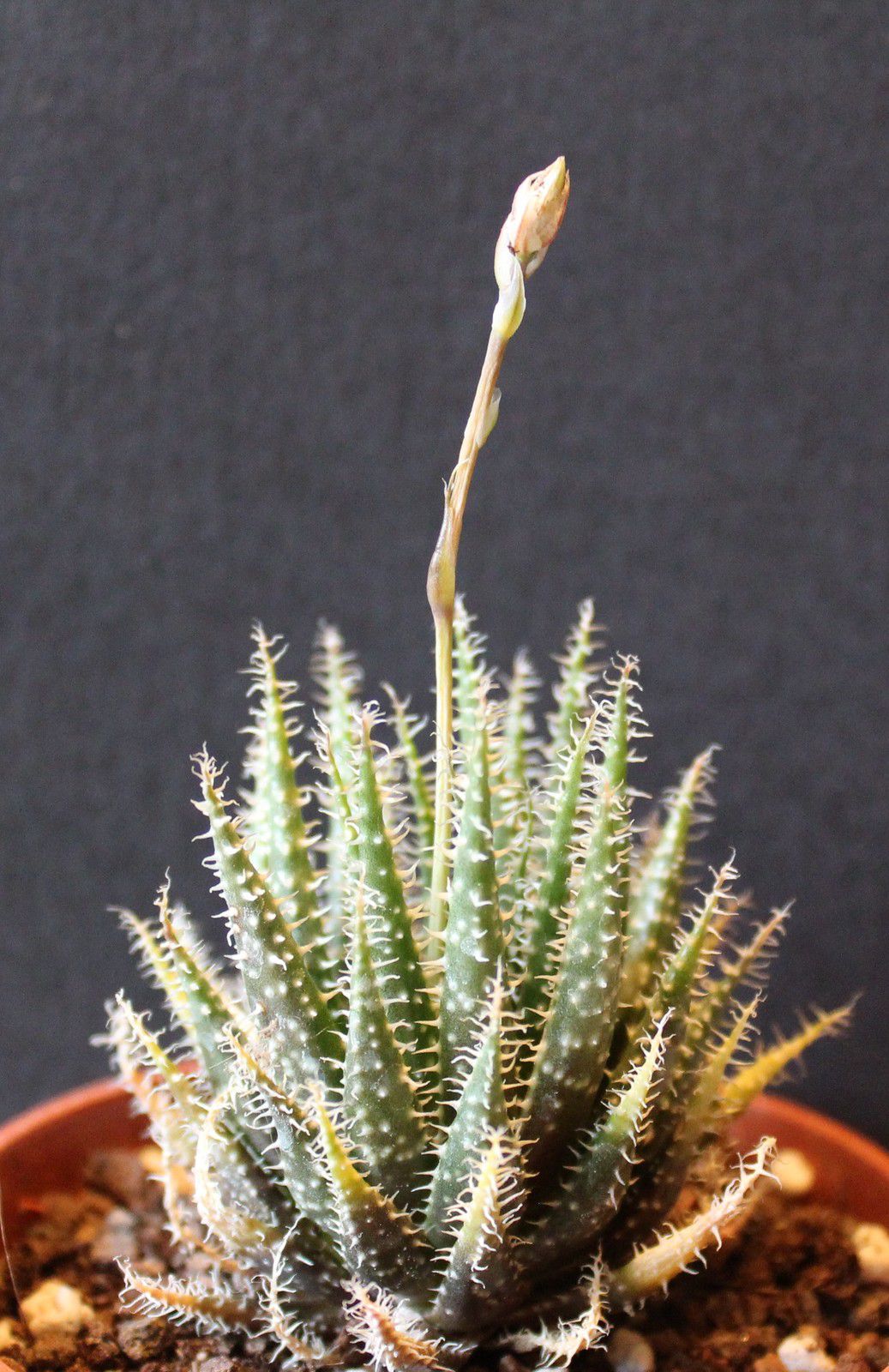Famille des Asphodelaceae
Genre: Aloe Linné 1753
Nom scientifique: Aloe haworthioides
Baker 1887
Distribution: Madagascar.
Etymologie: origine incertaine, de l'Arabe "alloch" = amère ou "alloeh", du Grec "aloe" ou de l'Hébreu "ahalim ou allal" = amère;
haworthioides, dérivé du Grec "-oides" = similaire à, par rapport à la ressemblance de la plante au genre Haworthia ;
(Haworthia, en l'honneur de Adrian H. Haworth (1768-1833), botaniste et zoologiste Anglais, spécialiste des plantes succulentes).
Synonymes: Aloinella haworthioides, Lemeea haworthioides.
Température de rusticité: -1 °C si tenu au sec.
Exposition: lumière très vive.
Culture: nécessite un substrat drainant de type cactées, plutôt acide. Arroser de Mars à Octobre puis hiverner au sec. Peut être arrosé une fois par mois l'hiver, par beau temps.


(Provenance: Alain Mouchel, 07700 Saint-Marcel d'Ardèche)
-------------------------------------------------------
Données supplémentaires
1) Aloe haworthioides Baker
Ce bel Aloe miniature doit son nom à sa ressemblance avec certaines espèces du genre Haworthia. Les feuilles, petites, portent des poils blancs très caractéristiques.
Répartition: Collines autour de Fianarantsoa; Zazafotsy; Andringitra. Alt 1200-2000 m.
Floraison: avril - mai.
Référence: D'après J.B. Castillon et J.P. Castillon, dans "Les Aloe de Madagascar", p 143; Editeur J.P. Castillon, 2010
2) A. haworthioides
Baker, J. Linn. Soc., Bot. 22:529 (1887)
Plant with fusiform roots, solitary or forming small groups. Leaves 30-35, densely rosulate, lanceolate-deltoid, 3-4 x 0.4 cm, terminating in a pellucid point, dark green, covered with white, pellucid pustules often tipped with a short, white hair; margins ciliate, with crowded, narrowly deltoid, softly cartilaginous, pellucid teeth, 1-2 mm long. Inflorescence simple, 20-30 cm tall. Raceme dense, 4-6 cm x 12 mm, with up to 30 flowers. Floral bracts almost orbicular with an acute tip, reddish, 5 x 4 mm. Pedicels none or negligible. Perianth white to pale pink, cylindrical, 6-8 mm long; outer tepals free to the base. Stamens remarkably thick and fleshy, 1 mm broad, exserted 5 mm, style exserted 5 mm.
Madagascar Central Plateau, without precise locality, Baron 3424 (K). Endemic to the mountains of the Batsileo country, around Fianarantsoa, growing in tufts of short, perennial grasses, in scanty, very acidic soil on granite domes or whale-backs, at altitudes of 1,200-1,800 M.
Référence: S. Carter, J.J. Lavranos, L.E. Newton, C.C Walker, dans "Aloes, The Definitive Guide", Kew Publishing Edition, p 394, 2011.

/image%2F1217490%2F20211216%2Fob_67e2e1_gymnocalycium-baldianum-9.JPG)


/image%2F1217490%2F20210904%2Fob_80574c_aloe-doran-black-23.JPG)
/image%2F1217490%2F20200209%2Fob_6b6b4c_aloe-melanacantha-2.JPG)
/image%2F1217490%2F20180529%2Fob_48bc3e_img-1476.JPG)
/idata%2F3917426%2FMes-succulentes%2FAloe-somaliensis--4-.JPG)
/image%2F1217490%2F20231001%2Fob_fe4155_epiphyllum-oxypetalum-4.JPG)
/image%2F1217490%2F20231001%2Fob_a20e8e_img-7333.JPG)
/image%2F1217490%2F20231001%2Fob_21283f_kalanchoe-tuniflora-1.JPG)
/image%2F1217490%2F20230121%2Fob_197e7c_blog-parodoa-procera-9.JPG)
/image%2F1217490%2F20230121%2Fob_b113e6_blog-mammillaria-perbella-7.JPG)
/image%2F1217490%2F20230121%2Fob_7e9446_blog-mammillaria-matudae-16.JPG)